Artificial Reproductive Technology in Female Dairy Sheep
VerifiedAdded on 2022/11/28
|13
|2123
|395
AI Summary
This article discusses the use of artificial reproductive technology, specifically cloning, in female dairy sheep. It explores the different types of cloning, historical developments in the field, and the impacts of cloning on the environment and animal welfare. The article also suggests alternative propositions for improving reproductive quality and output. Overall, the use of cloning in the dairy industry can lead to increased productivity and quality of livestock.
Contribute Materials
Your contribution can guide someone’s learning journey. Share your
documents today.
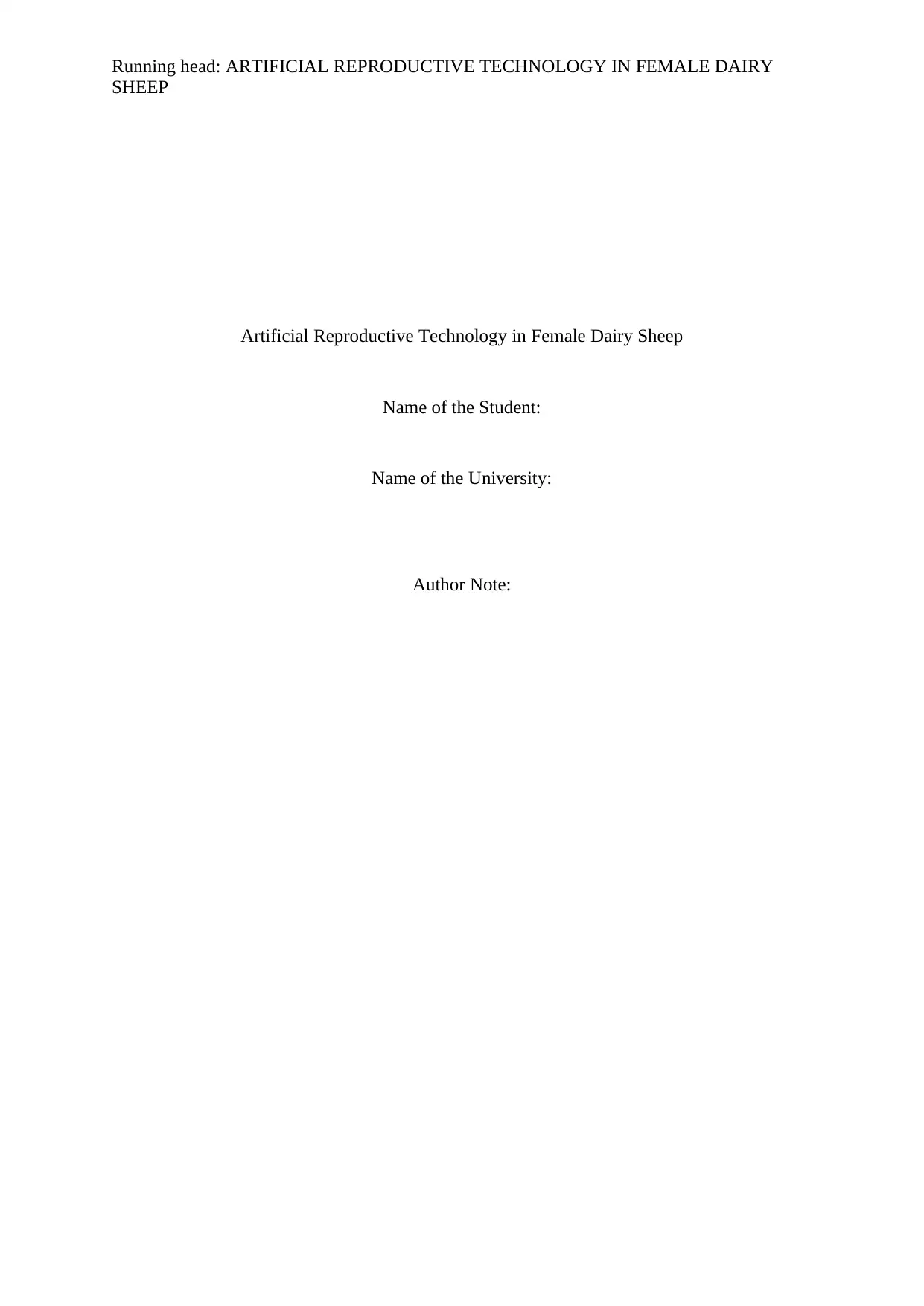
Running head: ARTIFICIAL REPRODUCTIVE TECHNOLOGY IN FEMALE DAIRY
SHEEP
Artificial Reproductive Technology in Female Dairy Sheep
Name of the Student:
Name of the University:
Author Note:
SHEEP
Artificial Reproductive Technology in Female Dairy Sheep
Name of the Student:
Name of the University:
Author Note:
Secure Best Marks with AI Grader
Need help grading? Try our AI Grader for instant feedback on your assignments.
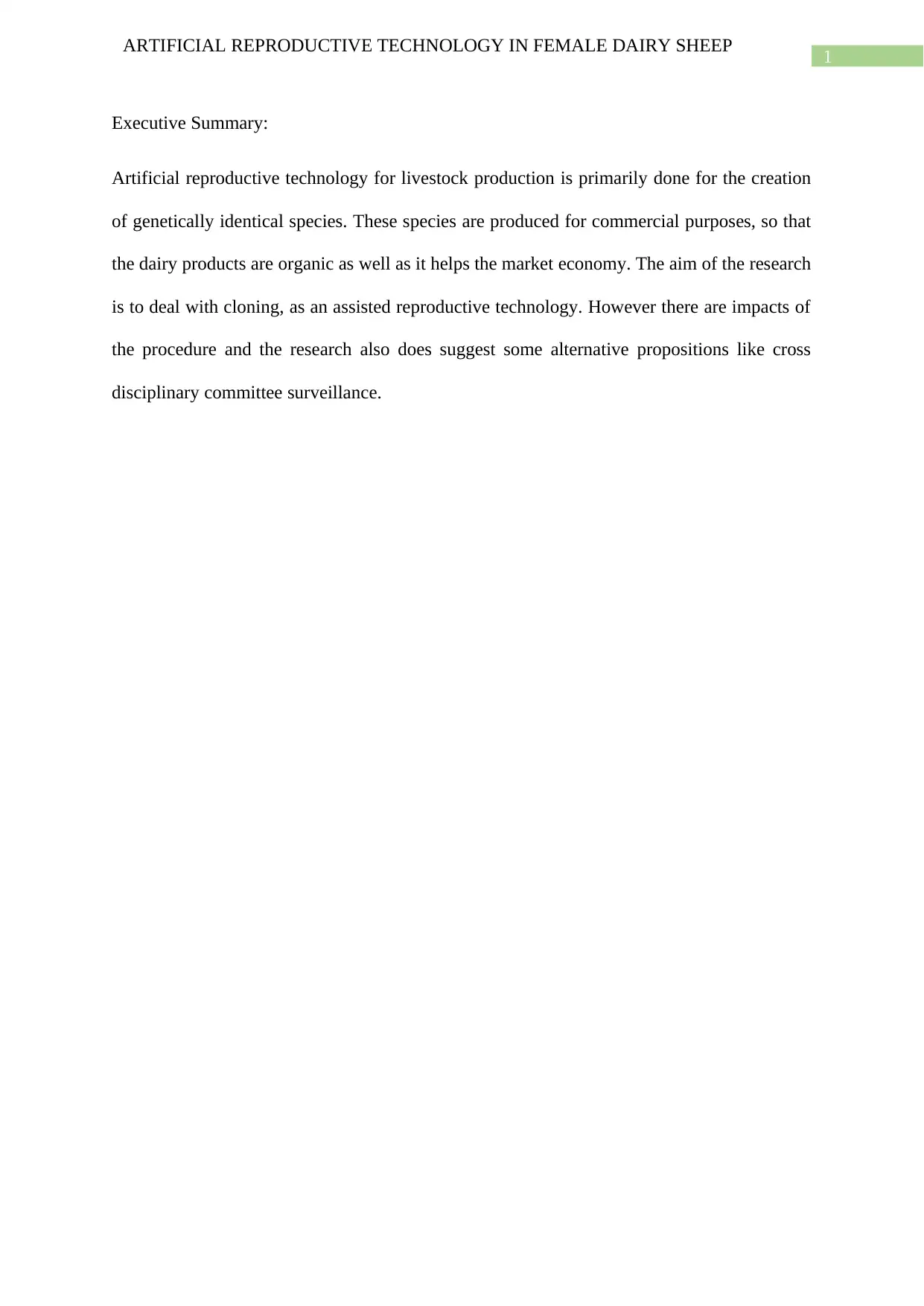
1
ARTIFICIAL REPRODUCTIVE TECHNOLOGY IN FEMALE DAIRY SHEEP
Executive Summary:
Artificial reproductive technology for livestock production is primarily done for the creation
of genetically identical species. These species are produced for commercial purposes, so that
the dairy products are organic as well as it helps the market economy. The aim of the research
is to deal with cloning, as an assisted reproductive technology. However there are impacts of
the procedure and the research also does suggest some alternative propositions like cross
disciplinary committee surveillance.
ARTIFICIAL REPRODUCTIVE TECHNOLOGY IN FEMALE DAIRY SHEEP
Executive Summary:
Artificial reproductive technology for livestock production is primarily done for the creation
of genetically identical species. These species are produced for commercial purposes, so that
the dairy products are organic as well as it helps the market economy. The aim of the research
is to deal with cloning, as an assisted reproductive technology. However there are impacts of
the procedure and the research also does suggest some alternative propositions like cross
disciplinary committee surveillance.
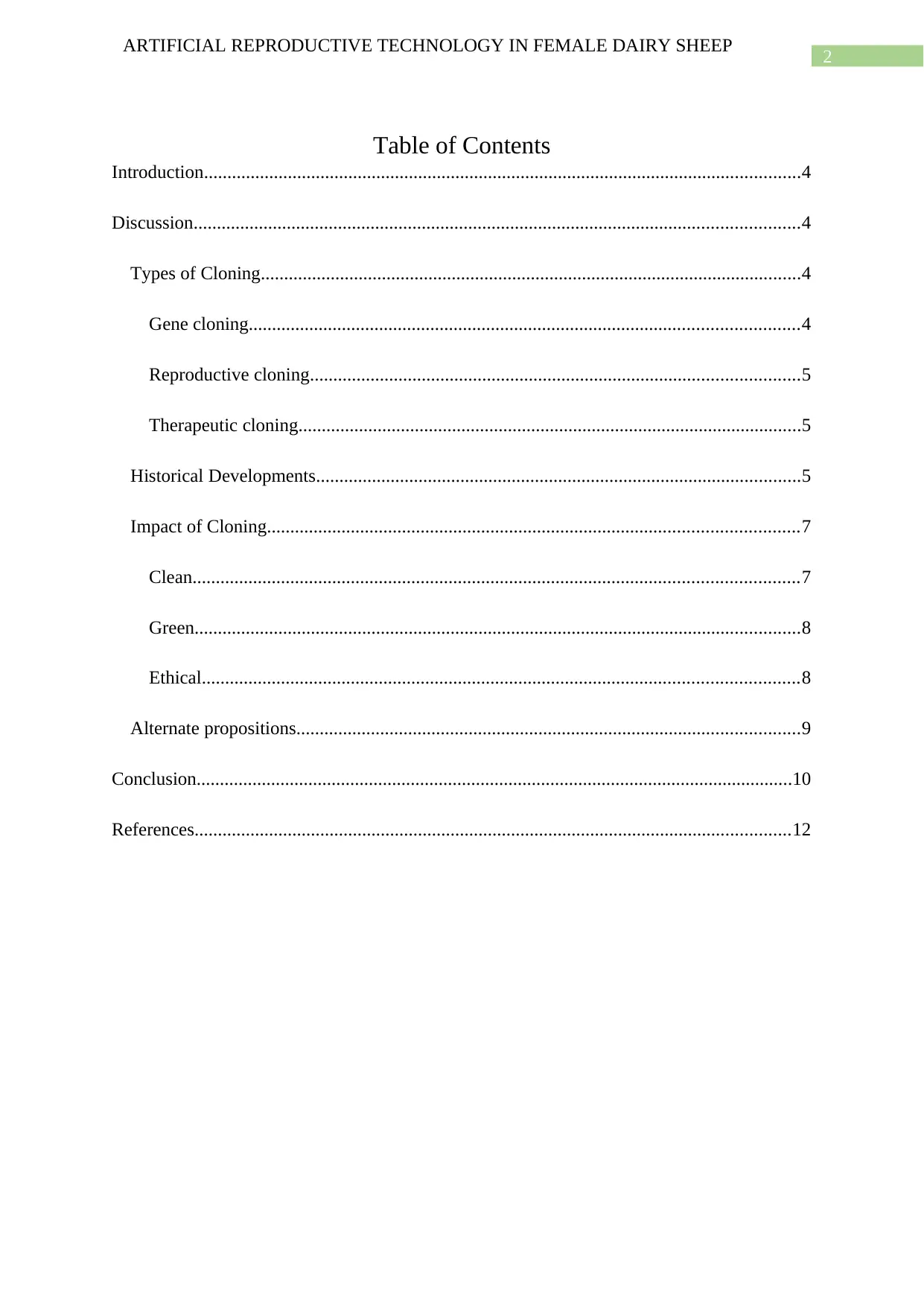
2
ARTIFICIAL REPRODUCTIVE TECHNOLOGY IN FEMALE DAIRY SHEEP
Table of Contents
Introduction................................................................................................................................4
Discussion..................................................................................................................................4
Types of Cloning....................................................................................................................4
Gene cloning......................................................................................................................4
Reproductive cloning.........................................................................................................5
Therapeutic cloning............................................................................................................5
Historical Developments........................................................................................................5
Impact of Cloning..................................................................................................................7
Clean..................................................................................................................................7
Green..................................................................................................................................8
Ethical................................................................................................................................8
Alternate propositions............................................................................................................9
Conclusion................................................................................................................................10
References................................................................................................................................12
ARTIFICIAL REPRODUCTIVE TECHNOLOGY IN FEMALE DAIRY SHEEP
Table of Contents
Introduction................................................................................................................................4
Discussion..................................................................................................................................4
Types of Cloning....................................................................................................................4
Gene cloning......................................................................................................................4
Reproductive cloning.........................................................................................................5
Therapeutic cloning............................................................................................................5
Historical Developments........................................................................................................5
Impact of Cloning..................................................................................................................7
Clean..................................................................................................................................7
Green..................................................................................................................................8
Ethical................................................................................................................................8
Alternate propositions............................................................................................................9
Conclusion................................................................................................................................10
References................................................................................................................................12
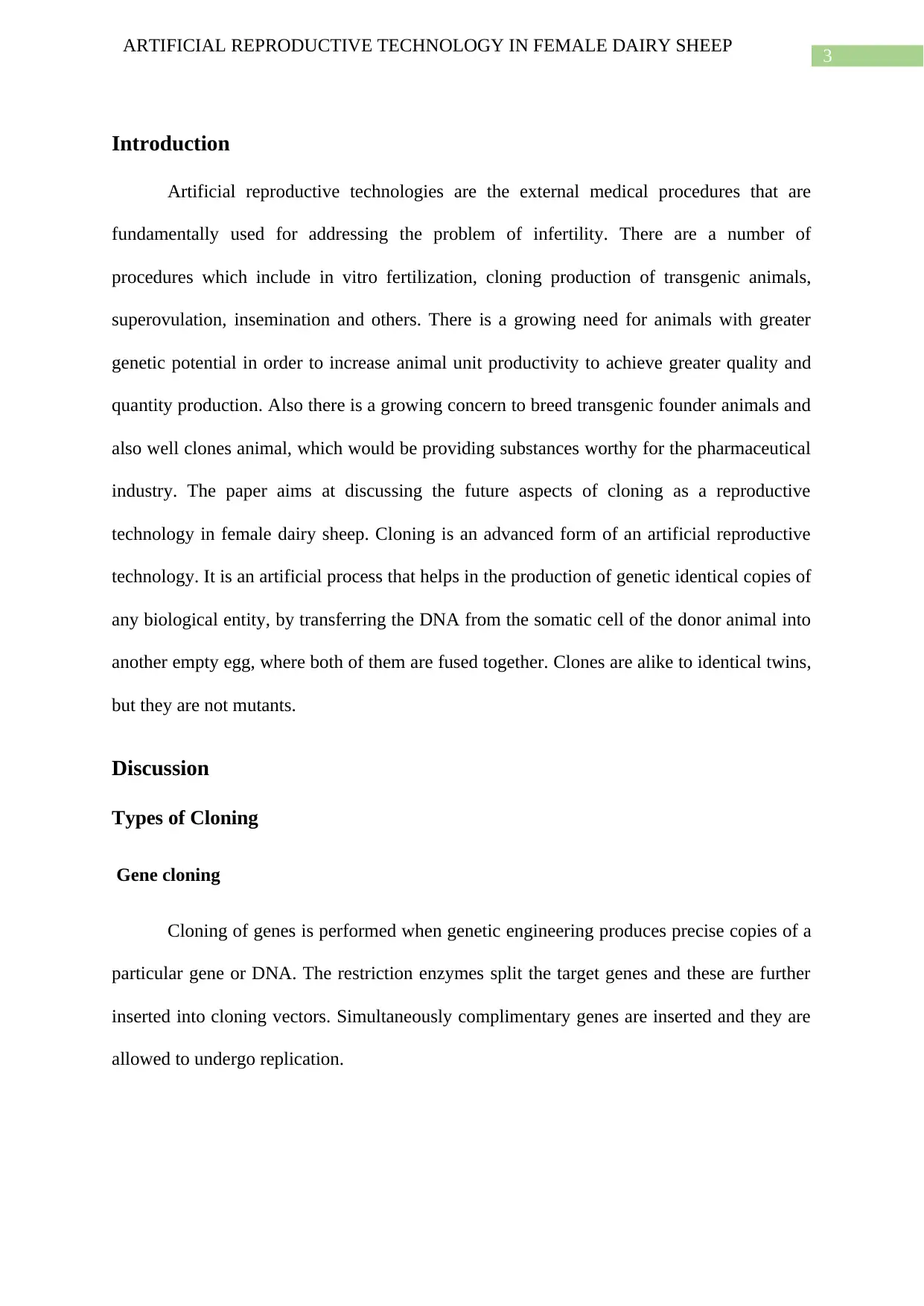
3
ARTIFICIAL REPRODUCTIVE TECHNOLOGY IN FEMALE DAIRY SHEEP
Introduction
Artificial reproductive technologies are the external medical procedures that are
fundamentally used for addressing the problem of infertility. There are a number of
procedures which include in vitro fertilization, cloning production of transgenic animals,
superovulation, insemination and others. There is a growing need for animals with greater
genetic potential in order to increase animal unit productivity to achieve greater quality and
quantity production. Also there is a growing concern to breed transgenic founder animals and
also well clones animal, which would be providing substances worthy for the pharmaceutical
industry. The paper aims at discussing the future aspects of cloning as a reproductive
technology in female dairy sheep. Cloning is an advanced form of an artificial reproductive
technology. It is an artificial process that helps in the production of genetic identical copies of
any biological entity, by transferring the DNA from the somatic cell of the donor animal into
another empty egg, where both of them are fused together. Clones are alike to identical twins,
but they are not mutants.
Discussion
Types of Cloning
Gene cloning
Cloning of genes is performed when genetic engineering produces precise copies of a
particular gene or DNA. The restriction enzymes split the target genes and these are further
inserted into cloning vectors. Simultaneously complimentary genes are inserted and they are
allowed to undergo replication.
ARTIFICIAL REPRODUCTIVE TECHNOLOGY IN FEMALE DAIRY SHEEP
Introduction
Artificial reproductive technologies are the external medical procedures that are
fundamentally used for addressing the problem of infertility. There are a number of
procedures which include in vitro fertilization, cloning production of transgenic animals,
superovulation, insemination and others. There is a growing need for animals with greater
genetic potential in order to increase animal unit productivity to achieve greater quality and
quantity production. Also there is a growing concern to breed transgenic founder animals and
also well clones animal, which would be providing substances worthy for the pharmaceutical
industry. The paper aims at discussing the future aspects of cloning as a reproductive
technology in female dairy sheep. Cloning is an advanced form of an artificial reproductive
technology. It is an artificial process that helps in the production of genetic identical copies of
any biological entity, by transferring the DNA from the somatic cell of the donor animal into
another empty egg, where both of them are fused together. Clones are alike to identical twins,
but they are not mutants.
Discussion
Types of Cloning
Gene cloning
Cloning of genes is performed when genetic engineering produces precise copies of a
particular gene or DNA. The restriction enzymes split the target genes and these are further
inserted into cloning vectors. Simultaneously complimentary genes are inserted and they are
allowed to undergo replication.
Secure Best Marks with AI Grader
Need help grading? Try our AI Grader for instant feedback on your assignments.
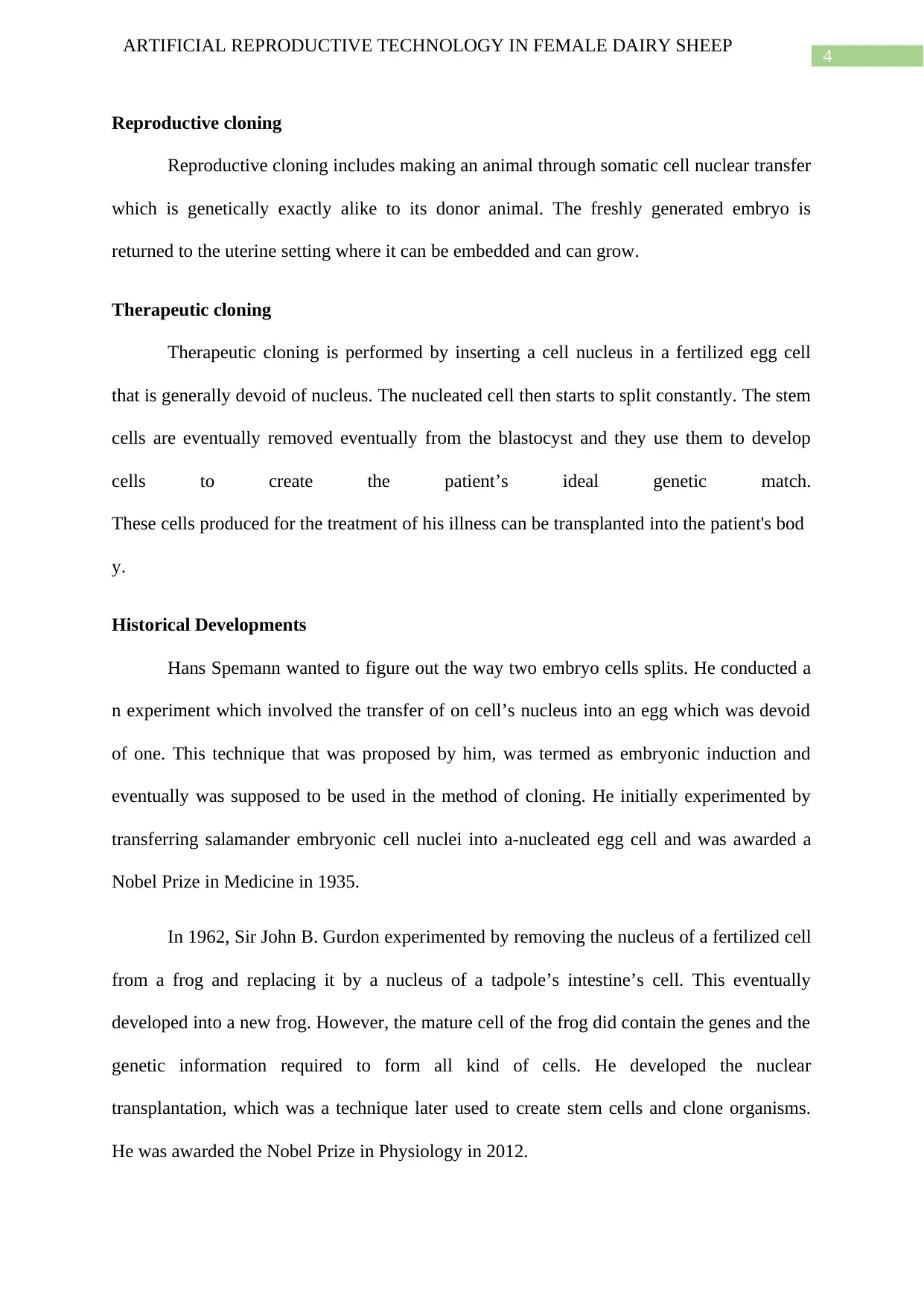
4
ARTIFICIAL REPRODUCTIVE TECHNOLOGY IN FEMALE DAIRY SHEEP
Reproductive cloning
Reproductive cloning includes making an animal through somatic cell nuclear transfer
which is genetically exactly alike to its donor animal. The freshly generated embryo is
returned to the uterine setting where it can be embedded and can grow.
Therapeutic cloning
Therapeutic cloning is performed by inserting a cell nucleus in a fertilized egg cell
that is generally devoid of nucleus. The nucleated cell then starts to split constantly. The stem
cells are eventually removed eventually from the blastocyst and they use them to develop
cells to create the patient’s ideal genetic match.
These cells produced for the treatment of his illness can be transplanted into the patient's bod
y.
Historical Developments
Hans Spemann wanted to figure out the way two embryo cells splits. He conducted a
n experiment which involved the transfer of on cell’s nucleus into an egg which was devoid
of one. This technique that was proposed by him, was termed as embryonic induction and
eventually was supposed to be used in the method of cloning. He initially experimented by
transferring salamander embryonic cell nuclei into a-nucleated egg cell and was awarded a
Nobel Prize in Medicine in 1935.
In 1962, Sir John B. Gurdon experimented by removing the nucleus of a fertilized cell
from a frog and replacing it by a nucleus of a tadpole’s intestine’s cell. This eventually
developed into a new frog. However, the mature cell of the frog did contain the genes and the
genetic information required to form all kind of cells. He developed the nuclear
transplantation, which was a technique later used to create stem cells and clone organisms.
He was awarded the Nobel Prize in Physiology in 2012.
ARTIFICIAL REPRODUCTIVE TECHNOLOGY IN FEMALE DAIRY SHEEP
Reproductive cloning
Reproductive cloning includes making an animal through somatic cell nuclear transfer
which is genetically exactly alike to its donor animal. The freshly generated embryo is
returned to the uterine setting where it can be embedded and can grow.
Therapeutic cloning
Therapeutic cloning is performed by inserting a cell nucleus in a fertilized egg cell
that is generally devoid of nucleus. The nucleated cell then starts to split constantly. The stem
cells are eventually removed eventually from the blastocyst and they use them to develop
cells to create the patient’s ideal genetic match.
These cells produced for the treatment of his illness can be transplanted into the patient's bod
y.
Historical Developments
Hans Spemann wanted to figure out the way two embryo cells splits. He conducted a
n experiment which involved the transfer of on cell’s nucleus into an egg which was devoid
of one. This technique that was proposed by him, was termed as embryonic induction and
eventually was supposed to be used in the method of cloning. He initially experimented by
transferring salamander embryonic cell nuclei into a-nucleated egg cell and was awarded a
Nobel Prize in Medicine in 1935.
In 1962, Sir John B. Gurdon experimented by removing the nucleus of a fertilized cell
from a frog and replacing it by a nucleus of a tadpole’s intestine’s cell. This eventually
developed into a new frog. However, the mature cell of the frog did contain the genes and the
genetic information required to form all kind of cells. He developed the nuclear
transplantation, which was a technique later used to create stem cells and clone organisms.
He was awarded the Nobel Prize in Physiology in 2012.
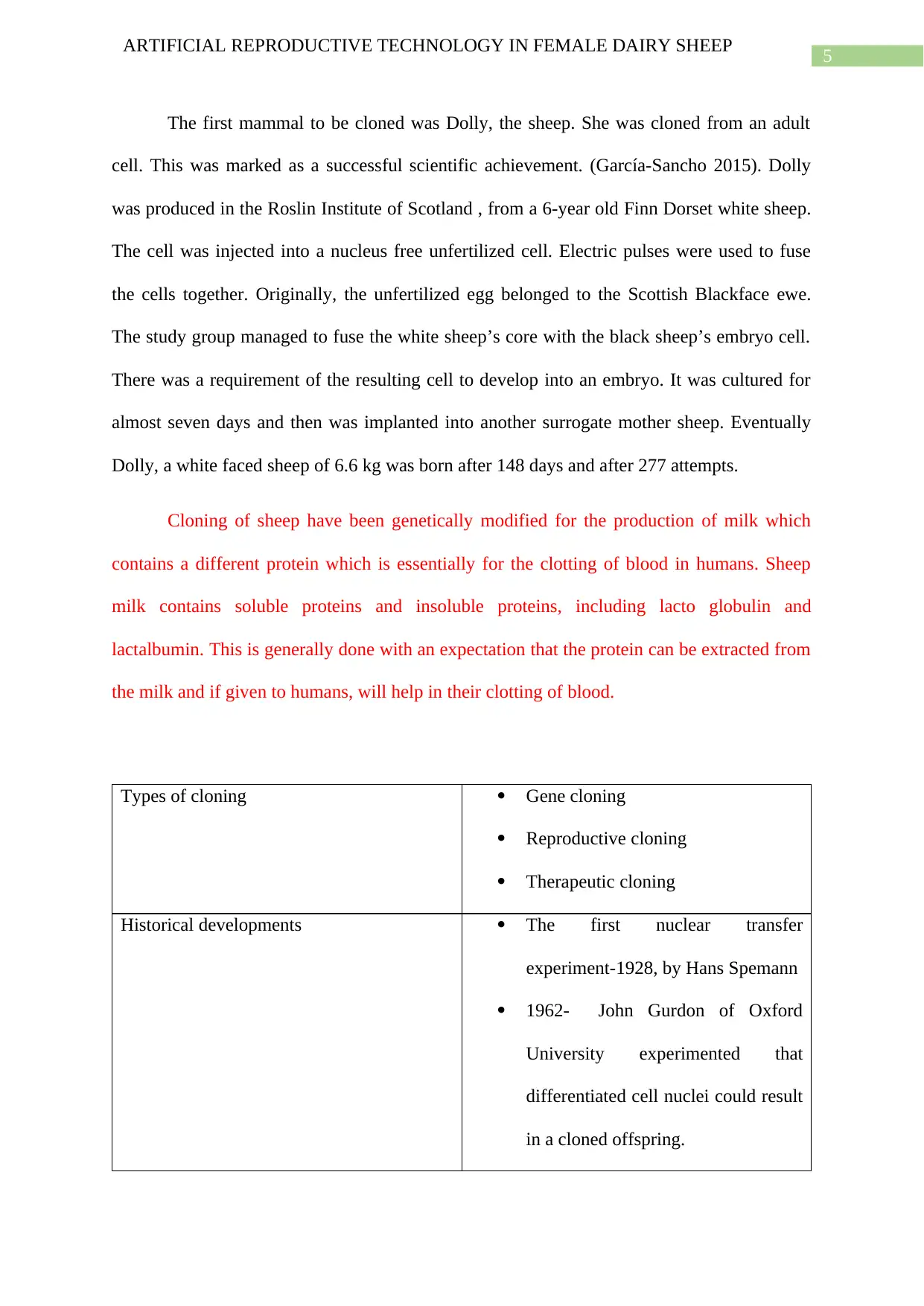
5
ARTIFICIAL REPRODUCTIVE TECHNOLOGY IN FEMALE DAIRY SHEEP
The first mammal to be cloned was Dolly, the sheep. She was cloned from an adult
cell. This was marked as a successful scientific achievement. (García-Sancho 2015). Dolly
was produced in the Roslin Institute of Scotland , from a 6-year old Finn Dorset white sheep.
The cell was injected into a nucleus free unfertilized cell. Electric pulses were used to fuse
the cells together. Originally, the unfertilized egg belonged to the Scottish Blackface ewe.
The study group managed to fuse the white sheep’s core with the black sheep’s embryo cell.
There was a requirement of the resulting cell to develop into an embryo. It was cultured for
almost seven days and then was implanted into another surrogate mother sheep. Eventually
Dolly, a white faced sheep of 6.6 kg was born after 148 days and after 277 attempts.
Cloning of sheep have been genetically modified for the production of milk which
contains a different protein which is essentially for the clotting of blood in humans. Sheep
milk contains soluble proteins and insoluble proteins, including lacto globulin and
lactalbumin. This is generally done with an expectation that the protein can be extracted from
the milk and if given to humans, will help in their clotting of blood.
Types of cloning Gene cloning
Reproductive cloning
Therapeutic cloning
Historical developments The first nuclear transfer
experiment-1928, by Hans Spemann
1962- John Gurdon of Oxford
University experimented that
differentiated cell nuclei could result
in a cloned offspring.
ARTIFICIAL REPRODUCTIVE TECHNOLOGY IN FEMALE DAIRY SHEEP
The first mammal to be cloned was Dolly, the sheep. She was cloned from an adult
cell. This was marked as a successful scientific achievement. (García-Sancho 2015). Dolly
was produced in the Roslin Institute of Scotland , from a 6-year old Finn Dorset white sheep.
The cell was injected into a nucleus free unfertilized cell. Electric pulses were used to fuse
the cells together. Originally, the unfertilized egg belonged to the Scottish Blackface ewe.
The study group managed to fuse the white sheep’s core with the black sheep’s embryo cell.
There was a requirement of the resulting cell to develop into an embryo. It was cultured for
almost seven days and then was implanted into another surrogate mother sheep. Eventually
Dolly, a white faced sheep of 6.6 kg was born after 148 days and after 277 attempts.
Cloning of sheep have been genetically modified for the production of milk which
contains a different protein which is essentially for the clotting of blood in humans. Sheep
milk contains soluble proteins and insoluble proteins, including lacto globulin and
lactalbumin. This is generally done with an expectation that the protein can be extracted from
the milk and if given to humans, will help in their clotting of blood.
Types of cloning Gene cloning
Reproductive cloning
Therapeutic cloning
Historical developments The first nuclear transfer
experiment-1928, by Hans Spemann
1962- John Gurdon of Oxford
University experimented that
differentiated cell nuclei could result
in a cloned offspring.
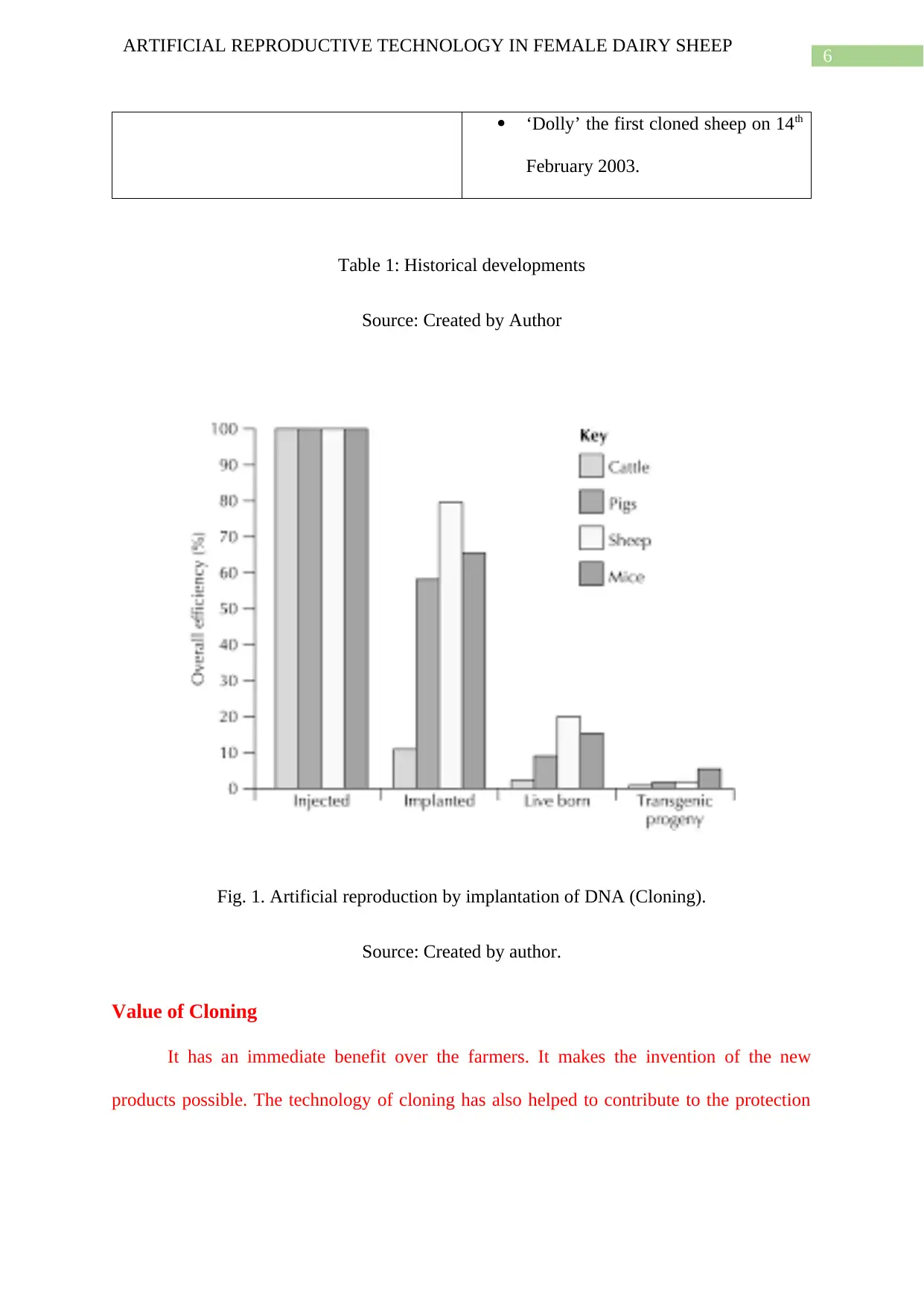
6
ARTIFICIAL REPRODUCTIVE TECHNOLOGY IN FEMALE DAIRY SHEEP
‘Dolly’ the first cloned sheep on 14th
February 2003.
Table 1: Historical developments
Source: Created by Author
Fig. 1. Artificial reproduction by implantation of DNA (Cloning).
Source: Created by author.
Value of Cloning
It has an immediate benefit over the farmers. It makes the invention of the new
products possible. The technology of cloning has also helped to contribute to the protection
ARTIFICIAL REPRODUCTIVE TECHNOLOGY IN FEMALE DAIRY SHEEP
‘Dolly’ the first cloned sheep on 14th
February 2003.
Table 1: Historical developments
Source: Created by Author
Fig. 1. Artificial reproduction by implantation of DNA (Cloning).
Source: Created by author.
Value of Cloning
It has an immediate benefit over the farmers. It makes the invention of the new
products possible. The technology of cloning has also helped to contribute to the protection
Paraphrase This Document
Need a fresh take? Get an instant paraphrase of this document with our AI Paraphraser
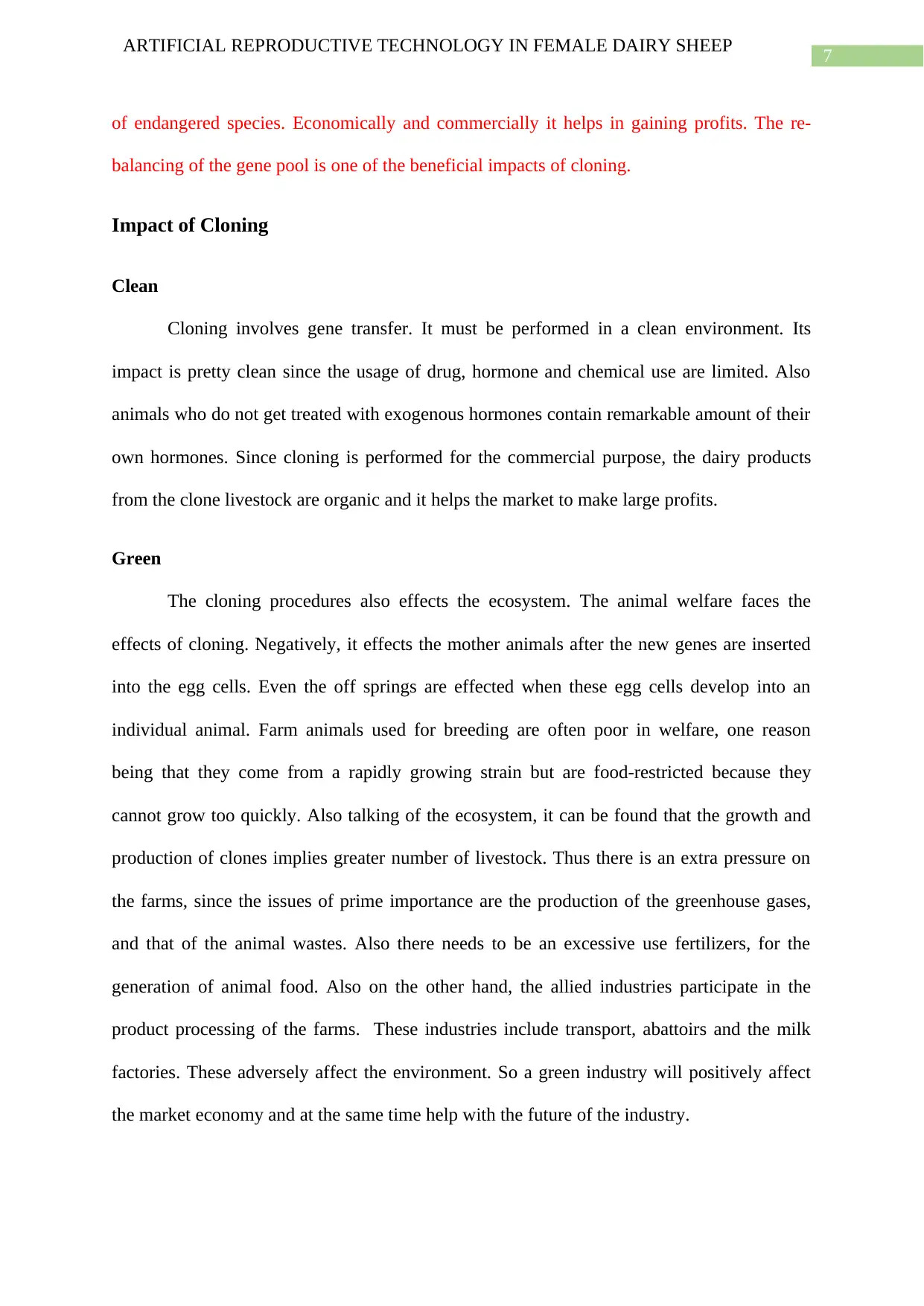
7
ARTIFICIAL REPRODUCTIVE TECHNOLOGY IN FEMALE DAIRY SHEEP
of endangered species. Economically and commercially it helps in gaining profits. The re-
balancing of the gene pool is one of the beneficial impacts of cloning.
Impact of Cloning
Clean
Cloning involves gene transfer. It must be performed in a clean environment. Its
impact is pretty clean since the usage of drug, hormone and chemical use are limited. Also
animals who do not get treated with exogenous hormones contain remarkable amount of their
own hormones. Since cloning is performed for the commercial purpose, the dairy products
from the clone livestock are organic and it helps the market to make large profits.
Green
The cloning procedures also effects the ecosystem. The animal welfare faces the
effects of cloning. Negatively, it effects the mother animals after the new genes are inserted
into the egg cells. Even the off springs are effected when these egg cells develop into an
individual animal. Farm animals used for breeding are often poor in welfare, one reason
being that they come from a rapidly growing strain but are food-restricted because they
cannot grow too quickly. Also talking of the ecosystem, it can be found that the growth and
production of clones implies greater number of livestock. Thus there is an extra pressure on
the farms, since the issues of prime importance are the production of the greenhouse gases,
and that of the animal wastes. Also there needs to be an excessive use fertilizers, for the
generation of animal food. Also on the other hand, the allied industries participate in the
product processing of the farms. These industries include transport, abattoirs and the milk
factories. These adversely affect the environment. So a green industry will positively affect
the market economy and at the same time help with the future of the industry.
ARTIFICIAL REPRODUCTIVE TECHNOLOGY IN FEMALE DAIRY SHEEP
of endangered species. Economically and commercially it helps in gaining profits. The re-
balancing of the gene pool is one of the beneficial impacts of cloning.
Impact of Cloning
Clean
Cloning involves gene transfer. It must be performed in a clean environment. Its
impact is pretty clean since the usage of drug, hormone and chemical use are limited. Also
animals who do not get treated with exogenous hormones contain remarkable amount of their
own hormones. Since cloning is performed for the commercial purpose, the dairy products
from the clone livestock are organic and it helps the market to make large profits.
Green
The cloning procedures also effects the ecosystem. The animal welfare faces the
effects of cloning. Negatively, it effects the mother animals after the new genes are inserted
into the egg cells. Even the off springs are effected when these egg cells develop into an
individual animal. Farm animals used for breeding are often poor in welfare, one reason
being that they come from a rapidly growing strain but are food-restricted because they
cannot grow too quickly. Also talking of the ecosystem, it can be found that the growth and
production of clones implies greater number of livestock. Thus there is an extra pressure on
the farms, since the issues of prime importance are the production of the greenhouse gases,
and that of the animal wastes. Also there needs to be an excessive use fertilizers, for the
generation of animal food. Also on the other hand, the allied industries participate in the
product processing of the farms. These industries include transport, abattoirs and the milk
factories. These adversely affect the environment. So a green industry will positively affect
the market economy and at the same time help with the future of the industry.
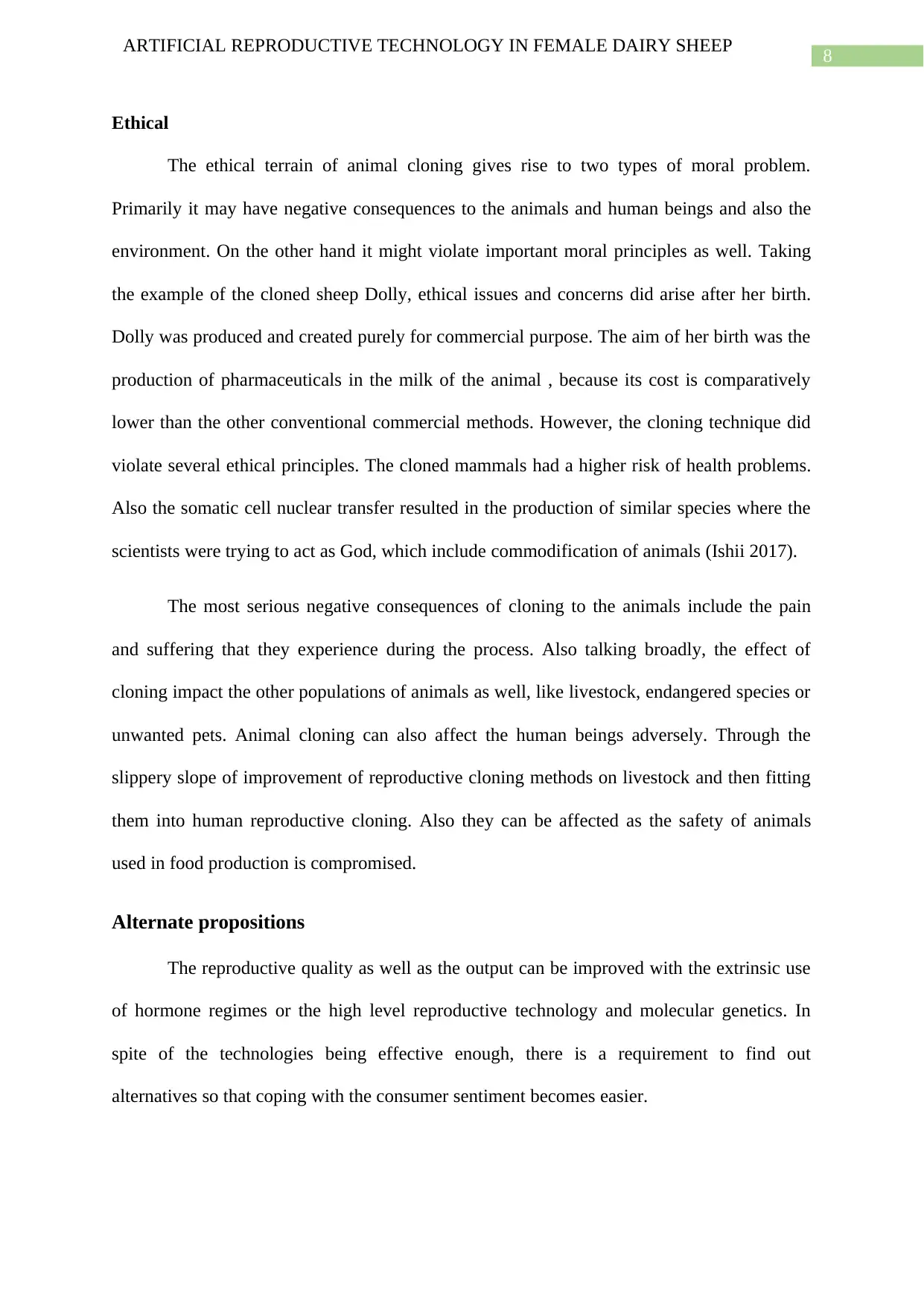
8
ARTIFICIAL REPRODUCTIVE TECHNOLOGY IN FEMALE DAIRY SHEEP
Ethical
The ethical terrain of animal cloning gives rise to two types of moral problem.
Primarily it may have negative consequences to the animals and human beings and also the
environment. On the other hand it might violate important moral principles as well. Taking
the example of the cloned sheep Dolly, ethical issues and concerns did arise after her birth.
Dolly was produced and created purely for commercial purpose. The aim of her birth was the
production of pharmaceuticals in the milk of the animal , because its cost is comparatively
lower than the other conventional commercial methods. However, the cloning technique did
violate several ethical principles. The cloned mammals had a higher risk of health problems.
Also the somatic cell nuclear transfer resulted in the production of similar species where the
scientists were trying to act as God, which include commodification of animals (Ishii 2017).
The most serious negative consequences of cloning to the animals include the pain
and suffering that they experience during the process. Also talking broadly, the effect of
cloning impact the other populations of animals as well, like livestock, endangered species or
unwanted pets. Animal cloning can also affect the human beings adversely. Through the
slippery slope of improvement of reproductive cloning methods on livestock and then fitting
them into human reproductive cloning. Also they can be affected as the safety of animals
used in food production is compromised.
Alternate propositions
The reproductive quality as well as the output can be improved with the extrinsic use
of hormone regimes or the high level reproductive technology and molecular genetics. In
spite of the technologies being effective enough, there is a requirement to find out
alternatives so that coping with the consumer sentiment becomes easier.
ARTIFICIAL REPRODUCTIVE TECHNOLOGY IN FEMALE DAIRY SHEEP
Ethical
The ethical terrain of animal cloning gives rise to two types of moral problem.
Primarily it may have negative consequences to the animals and human beings and also the
environment. On the other hand it might violate important moral principles as well. Taking
the example of the cloned sheep Dolly, ethical issues and concerns did arise after her birth.
Dolly was produced and created purely for commercial purpose. The aim of her birth was the
production of pharmaceuticals in the milk of the animal , because its cost is comparatively
lower than the other conventional commercial methods. However, the cloning technique did
violate several ethical principles. The cloned mammals had a higher risk of health problems.
Also the somatic cell nuclear transfer resulted in the production of similar species where the
scientists were trying to act as God, which include commodification of animals (Ishii 2017).
The most serious negative consequences of cloning to the animals include the pain
and suffering that they experience during the process. Also talking broadly, the effect of
cloning impact the other populations of animals as well, like livestock, endangered species or
unwanted pets. Animal cloning can also affect the human beings adversely. Through the
slippery slope of improvement of reproductive cloning methods on livestock and then fitting
them into human reproductive cloning. Also they can be affected as the safety of animals
used in food production is compromised.
Alternate propositions
The reproductive quality as well as the output can be improved with the extrinsic use
of hormone regimes or the high level reproductive technology and molecular genetics. In
spite of the technologies being effective enough, there is a requirement to find out
alternatives so that coping with the consumer sentiment becomes easier.
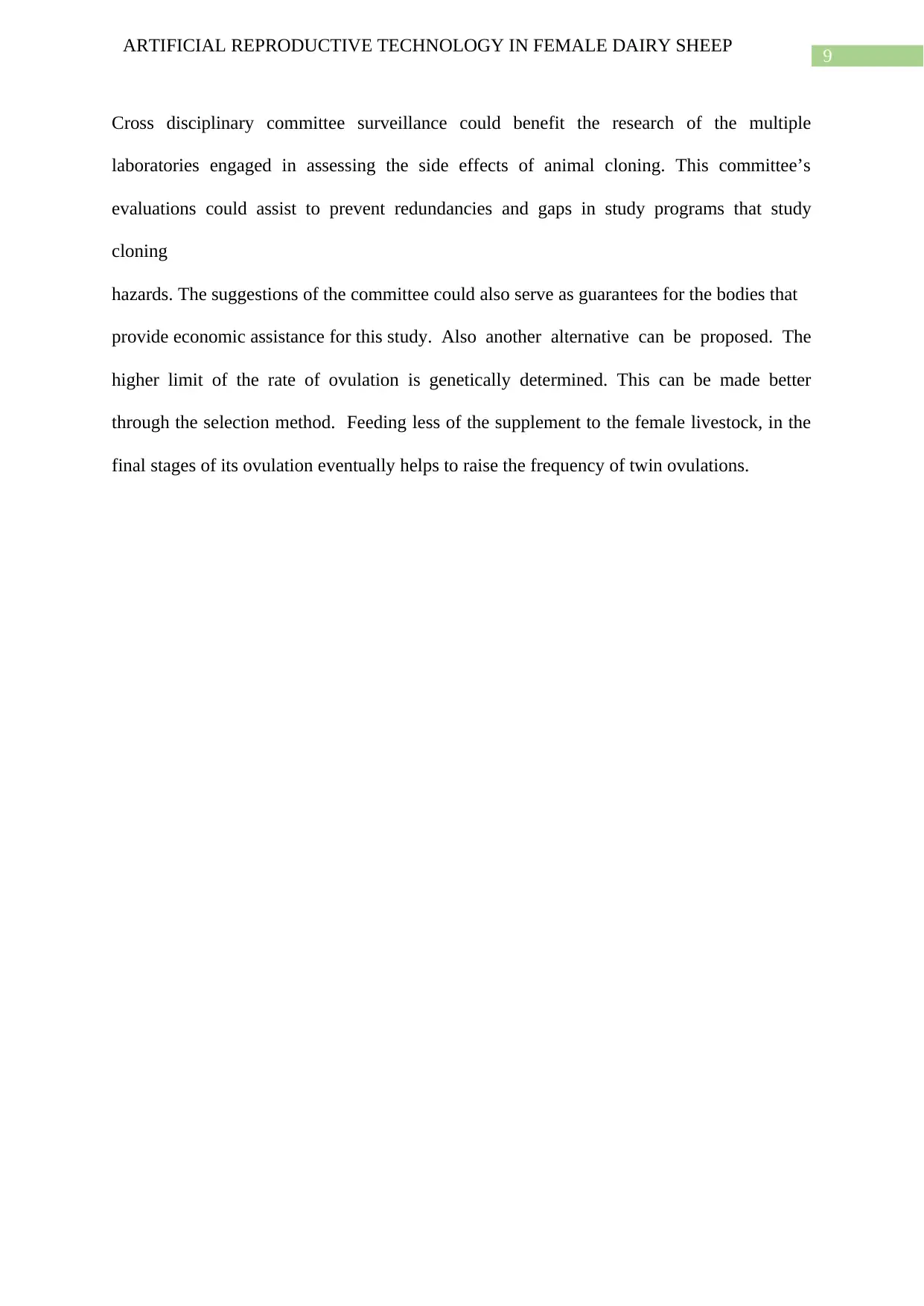
9
ARTIFICIAL REPRODUCTIVE TECHNOLOGY IN FEMALE DAIRY SHEEP
Cross disciplinary committee surveillance could benefit the research of the multiple
laboratories engaged in assessing the side effects of animal cloning. This committee’s
evaluations could assist to prevent redundancies and gaps in study programs that study
cloning
hazards. The suggestions of the committee could also serve as guarantees for the bodies that
provide economic assistance for this study. Also another alternative can be proposed. The
higher limit of the rate of ovulation is genetically determined. This can be made better
through the selection method. Feeding less of the supplement to the female livestock, in the
final stages of its ovulation eventually helps to raise the frequency of twin ovulations.
ARTIFICIAL REPRODUCTIVE TECHNOLOGY IN FEMALE DAIRY SHEEP
Cross disciplinary committee surveillance could benefit the research of the multiple
laboratories engaged in assessing the side effects of animal cloning. This committee’s
evaluations could assist to prevent redundancies and gaps in study programs that study
cloning
hazards. The suggestions of the committee could also serve as guarantees for the bodies that
provide economic assistance for this study. Also another alternative can be proposed. The
higher limit of the rate of ovulation is genetically determined. This can be made better
through the selection method. Feeding less of the supplement to the female livestock, in the
final stages of its ovulation eventually helps to raise the frequency of twin ovulations.
Secure Best Marks with AI Grader
Need help grading? Try our AI Grader for instant feedback on your assignments.
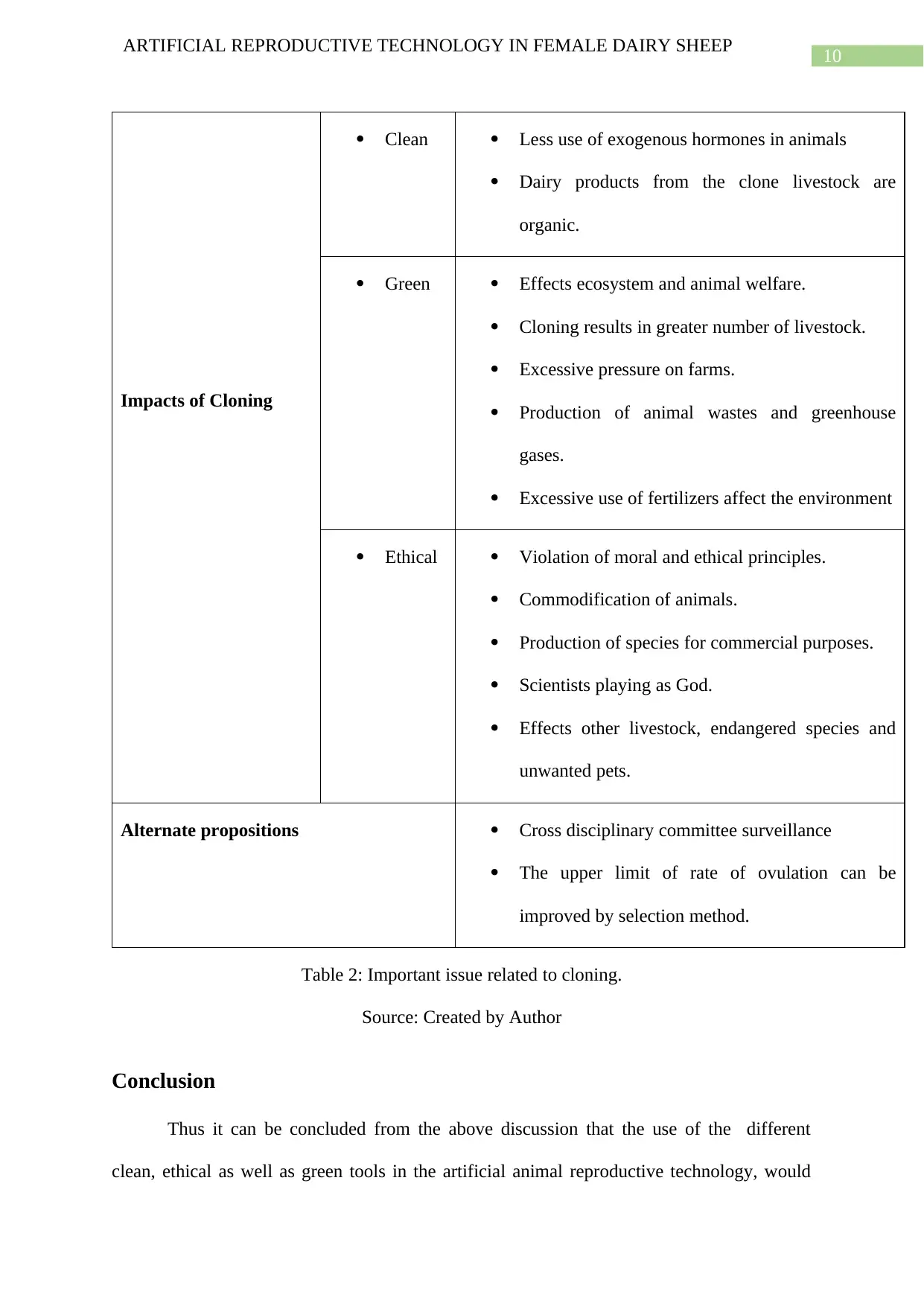
10
ARTIFICIAL REPRODUCTIVE TECHNOLOGY IN FEMALE DAIRY SHEEP
Clean Less use of exogenous hormones in animals
Dairy products from the clone livestock are
organic.
Impacts of Cloning
Green Effects ecosystem and animal welfare.
Cloning results in greater number of livestock.
Excessive pressure on farms.
Production of animal wastes and greenhouse
gases.
Excessive use of fertilizers affect the environment
Ethical Violation of moral and ethical principles.
Commodification of animals.
Production of species for commercial purposes.
Scientists playing as God.
Effects other livestock, endangered species and
unwanted pets.
Alternate propositions Cross disciplinary committee surveillance
The upper limit of rate of ovulation can be
improved by selection method.
Table 2: Important issue related to cloning.
Source: Created by Author
Conclusion
Thus it can be concluded from the above discussion that the use of the different
clean, ethical as well as green tools in the artificial animal reproductive technology, would
ARTIFICIAL REPRODUCTIVE TECHNOLOGY IN FEMALE DAIRY SHEEP
Clean Less use of exogenous hormones in animals
Dairy products from the clone livestock are
organic.
Impacts of Cloning
Green Effects ecosystem and animal welfare.
Cloning results in greater number of livestock.
Excessive pressure on farms.
Production of animal wastes and greenhouse
gases.
Excessive use of fertilizers affect the environment
Ethical Violation of moral and ethical principles.
Commodification of animals.
Production of species for commercial purposes.
Scientists playing as God.
Effects other livestock, endangered species and
unwanted pets.
Alternate propositions Cross disciplinary committee surveillance
The upper limit of rate of ovulation can be
improved by selection method.
Table 2: Important issue related to cloning.
Source: Created by Author
Conclusion
Thus it can be concluded from the above discussion that the use of the different
clean, ethical as well as green tools in the artificial animal reproductive technology, would
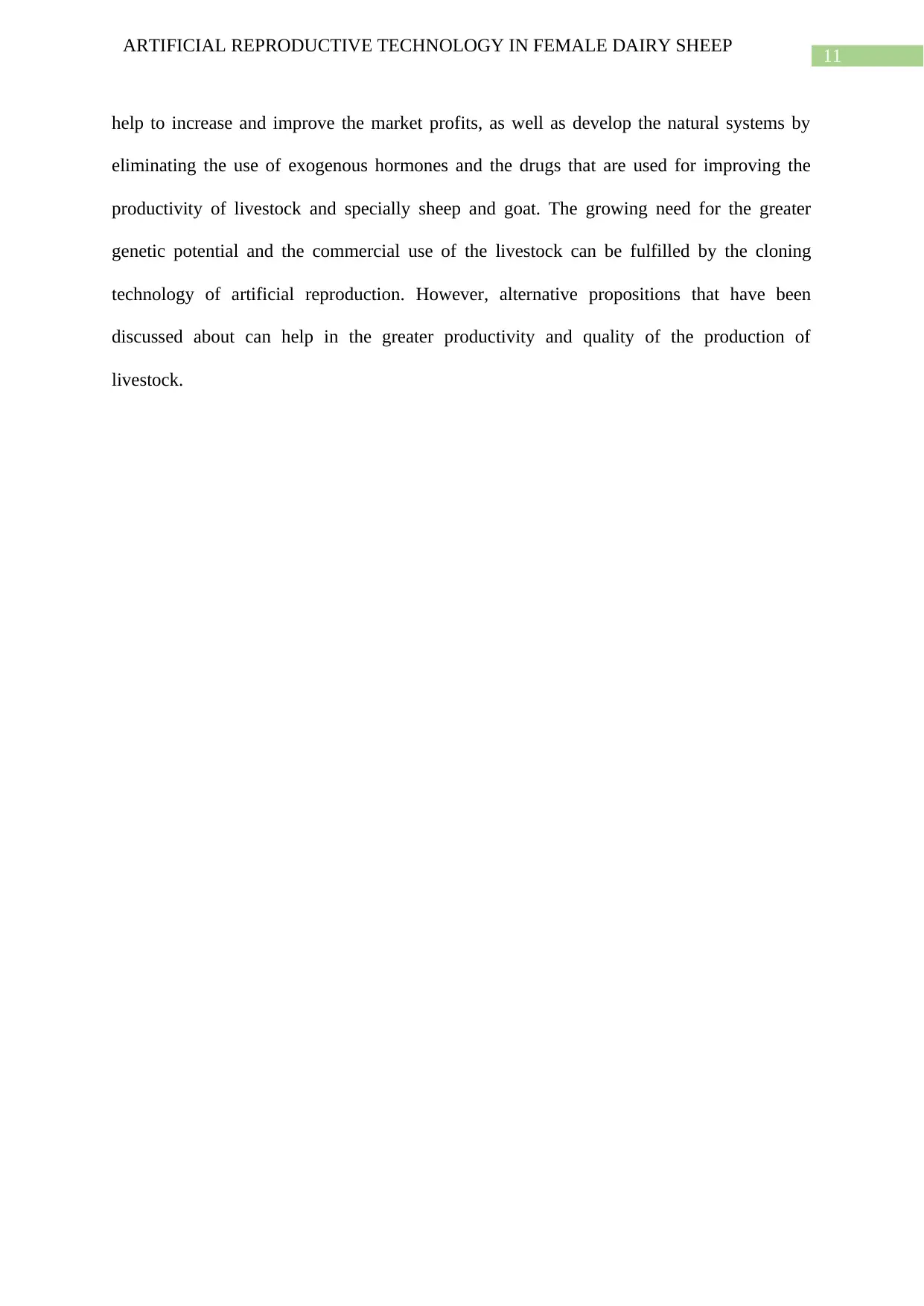
11
ARTIFICIAL REPRODUCTIVE TECHNOLOGY IN FEMALE DAIRY SHEEP
help to increase and improve the market profits, as well as develop the natural systems by
eliminating the use of exogenous hormones and the drugs that are used for improving the
productivity of livestock and specially sheep and goat. The growing need for the greater
genetic potential and the commercial use of the livestock can be fulfilled by the cloning
technology of artificial reproduction. However, alternative propositions that have been
discussed about can help in the greater productivity and quality of the production of
livestock.
ARTIFICIAL REPRODUCTIVE TECHNOLOGY IN FEMALE DAIRY SHEEP
help to increase and improve the market profits, as well as develop the natural systems by
eliminating the use of exogenous hormones and the drugs that are used for improving the
productivity of livestock and specially sheep and goat. The growing need for the greater
genetic potential and the commercial use of the livestock can be fulfilled by the cloning
technology of artificial reproduction. However, alternative propositions that have been
discussed about can help in the greater productivity and quality of the production of
livestock.
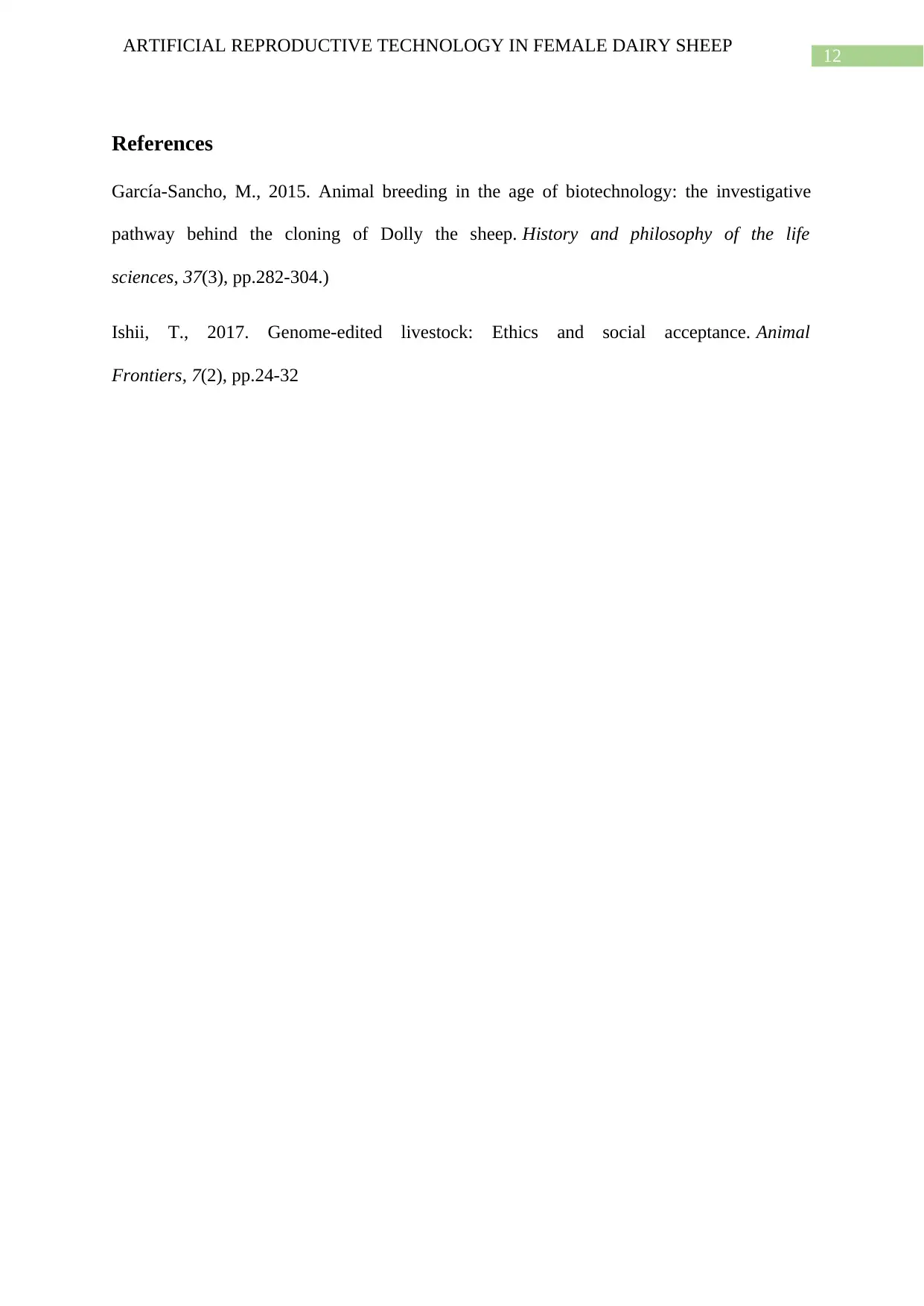
12
ARTIFICIAL REPRODUCTIVE TECHNOLOGY IN FEMALE DAIRY SHEEP
References
García-Sancho, M., 2015. Animal breeding in the age of biotechnology: the investigative
pathway behind the cloning of Dolly the sheep. History and philosophy of the life
sciences, 37(3), pp.282-304.)
Ishii, T., 2017. Genome-edited livestock: Ethics and social acceptance. Animal
Frontiers, 7(2), pp.24-32
ARTIFICIAL REPRODUCTIVE TECHNOLOGY IN FEMALE DAIRY SHEEP
References
García-Sancho, M., 2015. Animal breeding in the age of biotechnology: the investigative
pathway behind the cloning of Dolly the sheep. History and philosophy of the life
sciences, 37(3), pp.282-304.)
Ishii, T., 2017. Genome-edited livestock: Ethics and social acceptance. Animal
Frontiers, 7(2), pp.24-32
1 out of 13
Related Documents
Your All-in-One AI-Powered Toolkit for Academic Success.
+13062052269
info@desklib.com
Available 24*7 on WhatsApp / Email
![[object Object]](/_next/static/media/star-bottom.7253800d.svg)
Unlock your academic potential
© 2024 | Zucol Services PVT LTD | All rights reserved.




